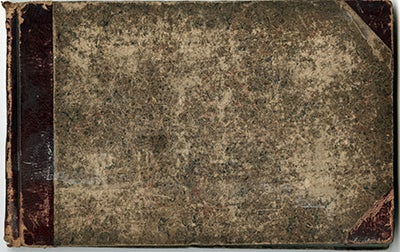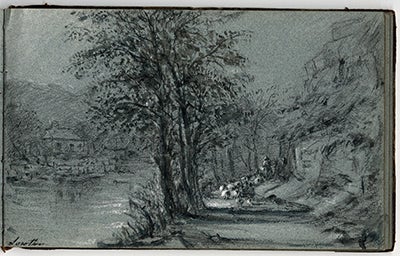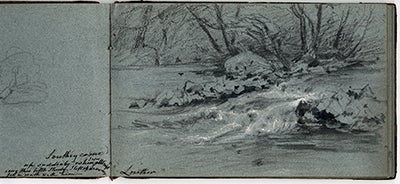It isn’t often one comes across an overlooked album of original landscape sketches by a noble-born lady who revolved among the circle of the Romantic poets. The Library recently received one such treasure with a generous donation of books and manuscripts from Stephen R. Graubard, an emeritus professor of history at Brown University and former editor of Daedalus, the journal of the American Academy of Arts and Sciences. An inscription inside the front cover traces its provenance to George Bentinck’s sale in 1891 and from thence purchased at a secondhand shop at Ridlers in 1892. Unfortunately, four of its pages were cut out by a previous owner.

Nevertheless, the remaining images are thoroughly enchanting. The album measures approximately 9 by 5 inches with 18 landscape views and studies of trees, along with some minor faint sketches on facing pages. Most of the pages are individually titled. The area depicted is Lowther in the Lake District in Cumbria, the region inhabited and popularized by poets William Wordsworth, Robert Southey and Samuel Taylor Coleridge. According to the inscription noted above, the sketches are by “Lady Fred Bentinck.” The artist was born Lady Mary Lowther (1785-1862) daughter of Sir William Lowther, the first Earl of Lonsdale and Lady Augusta Fane, daughter of the ninth Earl of Westmoreland. Sir William had Lowther Castle built between 1806 and 1813 on lands held by his ancestors over hundreds of years. The Earl and Countess of Lonsdale often hosted William Wordsworth and Robert Southey at Lowther, and both poets composed poetical tributes to the castle in honor of their friendship with its noble occupants. The Lowthers were active art patrons and commissioned J.M.W. Turner to paint two distant views of their estate which were both proudly displayed at the castle.
Lady Mary married Lord Frederick Cavendish-Bentinck in 1820, a Major General in the British Army who was later active in Parliament. Lord Frederick was the fourth son of the third Duke of Portland. Their marriage ended after eight years upon his untimely death while in Rome.
Lady Mary was tutored in art by Joseph Farington, who wrote favorably of her skills in his copious diaries, published by Yale University Press in 1982. She was also instructed by Peter De Wint, an English landscape painter patronized by her father. Wordsworth wrote a sonnet to Lady Mary which he presented to her in 1819 along with an anthology of English verse which he assembled specifically for her, the year prior to her marriage at the age of 35. Her landscape sketches, created that same year, are drawn in ink wash and charcoal with highlights of Chinese white on blue paper. They evocatively convey the environs surrounding Lowther, including Haweswater, Askham Bridge, Askham Mill and Elysian Fields. Some of the scenes are populated by tiny figures with sheep and a few lone canines as they appear to amble sedately along the paths and fields. Here and there, the artist added effective touches of white to convey the foam of the River Lowther or the wool of the herds. Next to a study of the water as it poured over some rocks, she commented, “Southey came up suddenly when I was attempting this little study. I left off drawing for a walk with him.”
The Wordsworth Trust’s collection at Dove Cottage in the Lake District includes a more finished pencil and wash drawing of Lowther Castle by Lady Mary, dated 1810 and on larger paper. It would be exciting to view that work together with the album and compare their varying technique and stylistic nuance. From the image online, the drawing at the Trust appears an accomplished architectural rendition. Perhaps it was a gift from Lady Mary to Wordsworth. The drawings in Georgetown’s album are informal onsite sketches, more purely Romantic in their interpretation of the beauty of nature. If the artist had been born of the opposite gender, I venture to speculate he would have enjoyed a successful career in the orbit of Turner and other landscape painters of the period.
--LuLen Walker, University Art Collection Curator
October 6, 2017


